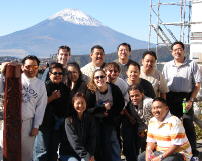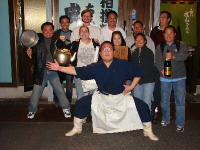 Just like yesterday, today was a whirlwind of sightseeing from morning to night. After touring Sensoji Temple we had lunch in the Asakusa area and then proceeded by train to the Sumo Museum at Ryogoku Kokugikan. Ryogoku is an area of Tokyo where the Kokugikan (sumo stadium) is located and the surrounding area is full of sumo stables and chankonabe restaurants.
Just like yesterday, today was a whirlwind of sightseeing from morning to night. After touring Sensoji Temple we had lunch in the Asakusa area and then proceeded by train to the Sumo Museum at Ryogoku Kokugikan. Ryogoku is an area of Tokyo where the Kokugikan (sumo stadium) is located and the surrounding area is full of sumo stables and chankonabe restaurants.Until the beginning of the 20th century, sumo tournaments were held outdoors at shrines and temples. In 1909, the first permanent sumo hall was built in the Ryogoku area, where outdoor sumo events had been held for a long time prior. The current Kokugikan is the fourth permanent sumo stadium built in Tokyo. It has been in use since 1985 and is located next to Ryogoku Station.

Now the question of the day is, in the picture above, where is the right hand of the middle sumo wrestler and why does the sumo wrestler on the far left look so upset?

As we approached the Kokugikan we were greeted by the sight of this huge tower called the Yagura-daiko or "tower drum". During sumo tournaments a huge drum that is mounted on top of the tall yagura (tower) is beaten loudly when the matches are about to begin.
I am told that the original yagura was over 50 feet high and was constructed of enormous cedar logs. The tower needed to be this high so that the sound of the drum would reflect off the surface of the nearby Sumida River and be heard all over the city. The current yagura seems to be made of more modern materials and comes equipped with an elevator.
The yagura-daiko is played twice a day during the tournament. The "yose-daiko" (coming drum set) is played early in the morning to gather people and the "hane-daiko" (leaving drum set) is played at the end of each day's matches to invite the audience to come back again the next day. http://www.sumo.or.jp/eng/museum/index.html


No comments:
Post a Comment